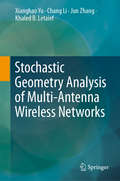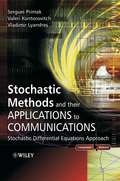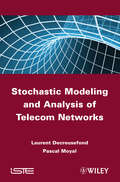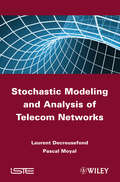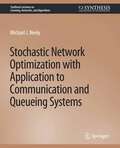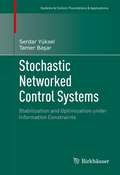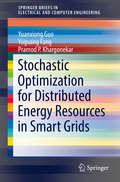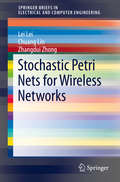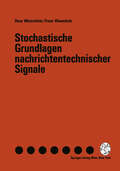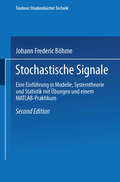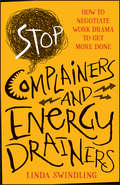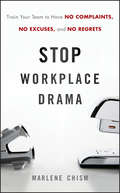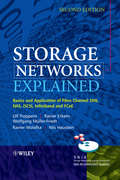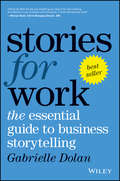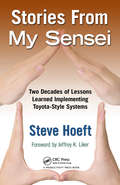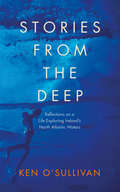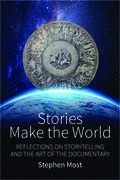- Table View
- List View
Stochastic Geometry Analysis of Multi-Antenna Wireless Networks
by Xianghao Yu Chang Li Jun Zhang Khaled B. LetaiefThis book presents a unified framework for the tractable analysis of large-scale, multi-antenna wireless networks using stochastic geometry. This mathematical analysis is essential for assessing and understanding the performance of complicated multi-antenna networks, which are one of the foundations of 5G and beyond networks to meet the ever-increasing demands for network capacity. Describing the salient properties of the framework, which makes the analysis of multi-antenna networks comparable to that of their single-antenna counterparts, the book discusses effective design approaches that do not require complex system-level simulations. It also includes various application examples with different multi-antenna network models to illustrate the framework’s effectiveness.
Stochastic Methods and their Applications to Communications: Stochastic Differential Equations Approach
by Serguei Primak Valeri Kontorovich Vladimir LyandresStochastic Methods & their Applications to Communications presents a valuable approach to the modelling, synthesis and numerical simulation of random processes with applications in communications and related fields. The authors provide a detailed account of random processes from an engineering point of view and illustrate the concepts with examples taken from the communications area. The discussions mainly focus on the analysis and synthesis of Markov models of random processes as applied to modelling such phenomena as interference and fading in communications. Encompassing both theory and practice, this original text provides a unified approach to the analysis and generation of continuous, impulsive and mixed random processes based on the Fokker-Planck equation for Markov processes. Presents the cumulated analysis of Markov processes Offers a SDE (Stochastic Differential Equations) approach to the generation of random processes with specified characteristics Includes the modelling of communication channels and interfer ences using SDE Features new results and techniques for the of solution of the generalized Fokker-Planck equation Essential reading for researchers, engineers, and graduate and upper year undergraduate students in the field of communications, signal processing, control, physics and other areas of science, this reference will have wide ranging appeal.
Stochastic Modeling and Analysis of Telecom Networks
by Laurent Decreusefond Pascal MoyalThis book addresses the stochastic modeling of telecommunication networks, introducing the main mathematical tools for that purpose, such as Markov processes, real and spatial point processes and stochastic recursions, and presenting a wide list of results on stability, performances and comparison of systems. The authors propose a comprehensive mathematical construction of the foundations of stochastic network theory: Markov chains, continuous time Markov chains are extensively studied using an original martingale-based approach. A complete presentation of stochastic recursions from an ergodic theoretical perspective is also provided, as well as spatial point processes. Using these basic tools, stability criteria, performance measures and comparison principles are obtained for a wide class of models, from the canonical M/M/1 and G/G/1 queues to more sophisticated systems, including the current “hot topics” of spatial radio networking, OFDMA and real-time networks. Contents 1. Introduction. Part 1: Discrete-time Modeling 2. Stochastic Recursive Sequences. 3. Markov Chains. 4. Stationary Queues. 5. The M/GI/1 Queue. Part 2: Continuous-time Modeling 6. Poisson Process. 7. Markov Process. 8. Systems with Delay. 9. Loss Systems. Part 3: Spatial Modeling 10. Spatial Point Processes.
Stochastic Modeling and Analysis of Telecom Networks
by Laurent Decreusefond Pascal MoyalThis book addresses the stochastic modeling of telecommunication networks, introducing the main mathematical tools for that purpose, such as Markov processes, real and spatial point processes and stochastic recursions, and presenting a wide list of results on stability, performances and comparison of systems. The authors propose a comprehensive mathematical construction of the foundations of stochastic network theory: Markov chains, continuous time Markov chains are extensively studied using an original martingale-based approach. A complete presentation of stochastic recursions from an ergodic theoretical perspective is also provided, as well as spatial point processes. Using these basic tools, stability criteria, performance measures and comparison principles are obtained for a wide class of models, from the canonical M/M/1 and G/G/1 queues to more sophisticated systems, including the current “hot topics” of spatial radio networking, OFDMA and real-time networks. Contents 1. Introduction. Part 1: Discrete-time Modeling 2. Stochastic Recursive Sequences. 3. Markov Chains. 4. Stationary Queues. 5. The M/GI/1 Queue. Part 2: Continuous-time Modeling 6. Poisson Process. 7. Markov Process. 8. Systems with Delay. 9. Loss Systems. Part 3: Spatial Modeling 10. Spatial Point Processes.
Stochastic Network Optimization with Application to Communication and Queueing Systems (Synthesis Lectures on Learning, Networks, and Algorithms)
by Michael NeelyThis text presents a modern theory of analysis, control, and optimization for dynamic networks. Mathematical techniques of Lyapunov drift and Lyapunov optimization are developed and shown to enable constrained optimization of time averages in general stochastic systems. The focus is on communication and queueing systems, including wireless networks with time-varying channels, mobility, and randomly arriving traffic. A simple drift-plus-penalty framework is used to optimize time averages such as throughput, throughput-utility, power, and distortion. Explicit performance-delay tradeoffs are provided to illustrate the cost of approaching optimality. This theory is also applicable to problems in operations research and economics, where energy-efficient and profit-maximizing decisions must be made without knowing the future. Topics in the text include the following: - Queue stability theory - Backpressure, max-weight, and virtual queue methods - Primal-dual methods for non-convex stochastic utility maximization - Universal scheduling theory for arbitrary sample paths - Approximate and randomized scheduling theory - Optimization of renewal systems and Markov decision systems Detailed examples and numerous problem set questions are provided to reinforce the main concepts. Table of Contents: Introduction / Introduction to Queues / Dynamic Scheduling Example / Optimizing Time Averages / Optimizing Functions of Time Averages / Approximate Scheduling / Optimization of Renewal Systems / Conclusions
Stochastic Networked Control Systems: Stabilization and Optimization under Information Constraints (Systems & Control: Foundations & Applications)
by Serdar Yüksel Tamer BaşarNetworked control systems are increasingly ubiquitous today, with applications ranging from vehicle communication and adaptive power grids to space exploration and economics. The optimal design of such systems presents major challenges, requiring tools from various disciplines within applied mathematics such as decentralized control, stochastic control, information theory, and quantization. A thorough, self-contained book, Stochastic Networked Control Systems: Stabilization and Optimization under Information Constraints aims to connect these diverse disciplines with precision and rigor, while conveying design guidelines to controller architects. Unique in the literature, it lays a comprehensive theoretical foundation for the study of networked control systems, and introduces an array of concrete tools for work in the field. Salient features included: · Characterization, comparison and optimal design of information structures in static and dynamic teams. Operational, structural and topological properties of information structures in optimal decision making, with a systematic program for generating optimal encoding and control policies. The notion of signaling, and its utilization in stabilization and optimization of decentralized control systems. · Presentation of mathematical methods for stochastic stability of networked control systems using random-time, state-dependent drift conditions and martingale methods. · Characterization and study of information channels leading to various forms of stochastic stability such as stationarity, ergodicity, and quadratic stability; and connections with information and quantization theories. Analysis of various classes of centralized and decentralized control systems. · Jointly optimal design of encoding and control policies over various information channels and under general optimization criteria, including a detailed coverage of linear-quadratic-Gaussian models. · Decentralized agreement and dynamic optimization under information constraints. This monograph is geared toward a broad audience of academic and industrial researchers interested in control theory, information theory, optimization, economics, and applied mathematics. It could likewise serve as a supplemental graduate text. The reader is expected to have some familiarity with linear systems, stochastic processes, and Markov chains, but the necessary background can also be acquired in part through the four appendices included at the end. · Characterization, comparison and optimal design of information structures in static and dynamic teams. Operational, structural and topological properties of information structures in optimal decision making, with a systematic program for generating optimal encoding and control policies. The notion of signaling, and its utilization in stabilization and optimization of decentralized control systems. · Presentation of mathematical methods for stochastic stability of networked control systems using random-time, state-dependent drift conditions and martingale methods. · Characterization and study of information channels leading to various forms of stochastic stability such as stationarity, ergodicity, and quadratic stability; and connections with information and quantization theories. Analysis of various classes of centralized and decentralized control systems. · Jointly optimal design of encoding and control policies over various information channels and under general optimization criteria, including a detailed coverage of linear-quadratic-Gaussian models. · Decentralized agreement and dynamic optimization under information constraints. This monograph is geared toward a broad audience of academic and industrial researchers interested in control theory, information theory, optimization, economics, and applied mathematics. It
Stochastic Optimization for Distributed Energy Resources in Smart Grids (SpringerBriefs in Electrical and Computer Engineering)
by Yuanxiong Guo Yuguang Fang Pramod P. KhargonekarThis brief focuses on stochastic energy optimization for distributed energy resources in smart grids. Along with a review of drivers and recent developments towards distributed energy resources, this brief presents research challenges of integrating millions of distributed energy resources into the grid. The brief then proposes a novel three-level hierarchical architecture for effectively integrating distributed energy resources into smart grids. Under the proposed hierarchical architecture, distributed energy resource management algorithms at the three levels (i.e., smart home, smart neighborhood, and smart microgrid) are developed in this brief based on stochastic optimization that can handle the involved uncertainties in the system.
Stochastic Petri Nets for Wireless Networks (SpringerBriefs in Electrical and Computer Engineering)
by Lei Lei Chuang Lin Zhangdui ZhongThis SpringerBrief presents research in the application of Stochastic Petri Nets (SPN) to the performance evaluation of wireless networks under bursty traffic. It covers typical Quality-of-Service performance metrics such as mean throughput, average delay and packet dropping probability. Along with an introduction of SPN basics, the authors introduce the key motivation and challenges of using SPN to analyze the resource sharing performance in wireless networks. The authors explain two powerful modeling techniques that treat the well-known state space explosion problem: model decomposition and iteration, and model aggregation using stochastic high-level petri nets. The first technique assists in performance analysis of opportunistic scheduling, Device-to-Device communications with full frequency reuse and partial frequency reuse. The second technique is used to formulate a wireless channel mode for cross-layer performance analysis in OFDM system. Stochastic Petri Nets for Wireless Networks reveals useful insights for the design of radio resource management algorithms and a new line of thinking for the performance evaluation of future wireless networks. This material is valuable as a reference for researchers and professionals working in wireless networks and for advanced-level students studying wireless technologies in electrical engineering or computer science.
Stochastische Grundlagen nachrichtentechnischer Signale
by Hans Weinrichter Franz HlawatschDieses Buch bietet eine Einführung in die Theorie der statistischen Signalbeschreibung mit spezieller Betonung der digitalen Nachrichtenübertragungstechnik. Im ersten Kapitel wird der Begriff eines nachrichtentechnischen Signals und seine Beschreibungsmöglichkeiten kurz erläutert. Das zweite Kapitel geht speziell auf den Aspekt der Zufälligkeit und Unbestimmtheit von Signalen ein. Dabei wird die praktische Anwendung der Wahrscheinlichkeitstheorie auf die fundamentalen Probleme der Nachrichtenübertragung dargestellt. Der Begriff der Information und seine Anwendung auf Quellencodierung und Kanalkapazität werden anhand einfacher Beispiele erklärt. Das dritte Kapitel führt den Begriff der Zufallsvariablen und ihrer Beschreibung durch Verteilungsfunktion, Wahrscheinlichkeitsdichte und Erwartungswerte ein. Anschließend werden die Grundgedanken der Schätzung von Parametern von Verteilungsfunktionen und charakteristische Eigenschaften wie Varianz und Bias erklärt. Weitere Kapitel befassen sich mit der Modellierung von Nutzsignalen und Störungen, wichtigen Beschreibungsmöglichkeiten wie AKF und Leistungsdichtespektrum sowie speziellen stochastischen Prozessen und deren mathematischer Beschreibung. Abschließend werden noch binäre Pseudozufallsfolgen sowie die Anwendung des Konzepts stochastischer Prozesse auf den Entwurf von Systemen zur Signalverarbeitung diskutiert. Bei der Aufbereitung des Stoffes wurde auf größtmögliche Anschaulichkeit und Lesbarkeit Wert gelegt. Die Beschreibung der angesprochenen Sachverhalte wurde soweit formalisiert, daß dem Leser ein tieferes Endringen in weiterführende Litertur ohne Probleme möglich sein wird.
Stochastische Signale: Eine Einführung in Modelle, Systemtheorie und Statistik mit Übungen und einem MATLAB-Praktikum (Teubner Studienbücher Technik)
by Johann Frederic BöhmeDas Buch wendet sich an Leser, die sich gründlich in die Theorie stochastischer Signale einarbeiten wollen. Im ersten Teil werden in einem Grundkurs die notwendigen Werkzeuge der Stochastik erarbeitet, im zweiten Teil stochastische Signale behandelt. Zahlreiche Beispiele, Übungsaufgaben und Lösungsskizzen, Anhänge, Tabellen für Standardverteilungen und ein Praktikum in MATLAB mit Simulationsaufgaben erleichtern das Selbststudium und die Anwendungen in der Praxis.
Stop Complainers and Energy Drainers: How to Negotiate Work Drama to Get More Done
by Linda Byars SwindlingTurn constant complainers into productive contributors Constant complainers take up resources, time, and mental bandwidth in the workplace. When you change a culture of complainers to one of contributors, you boost morale, increase productivity, and promote effective communication. In short, you get more done with less drama. In Stop Complainers and Energy Drainers, workplace communication expert Linda Swindling shares her expertise in negotiating tough situations in the workplace. Discover how to influence others to accomplish your purpose. Stop Complainers and Energy Drainers uses scenarios, engaging questions, and survey results to provide strategies that can be implemented immediately. Shows how to identify complainers and time drainers Provides forms to help prepare for discussions, suggested language to show up powerfully, and encouragement to apply strategies Offers concrete phrases and tactics to refocus a complainer and end unproductive conversations Stop Complainers and Energy Drainers is research-driven and focused on how to identify as well as manage conversations with "venters," complainers, whiners, and energy drainers. With these guidelines for communication, you'll see powerful results, improved relationships, and increased confidence.
Stop Complainers and Energy Drainers: How to Negotiate Work Drama to Get More Done
by Linda Byars SwindlingTurn constant complainers into productive contributors Constant complainers take up resources, time, and mental bandwidth in the workplace. When you change a culture of complainers to one of contributors, you boost morale, increase productivity, and promote effective communication. In short, you get more done with less drama. In Stop Complainers and Energy Drainers, workplace communication expert Linda Swindling shares her expertise in negotiating tough situations in the workplace. Discover how to influence others to accomplish your purpose. Stop Complainers and Energy Drainers uses scenarios, engaging questions, and survey results to provide strategies that can be implemented immediately. Shows how to identify complainers and time drainers Provides forms to help prepare for discussions, suggested language to show up powerfully, and encouragement to apply strategies Offers concrete phrases and tactics to refocus a complainer and end unproductive conversations Stop Complainers and Energy Drainers is research-driven and focused on how to identify as well as manage conversations with "venters," complainers, whiners, and energy drainers. With these guidelines for communication, you'll see powerful results, improved relationships, and increased confidence.
STOP PEOPLE PLEASING And Find Your Power
by Hailey Paige MageeDo you find it hard to say "no" to people? Do you tend to put others first? Do you feel guilty setting boundaries? If the answer to any of these questions is "yes", you may be a people pleaser.People-pleasing is a widespread but misunderstood response to trauma. It can have a huge impact on your mental health, showing up in common psychological conditions including anxiety, co-dependence, and depression. Left unchallenged, people-pleasing habits can lead to chronic discomfort, exhaustion, and resentment.In Stop People Pleasing, certified life coach Hailey Magee offers an action-based approach to breaking the people-pleasing pattern. Drawing on social science, psychological research, and coaching exercises, Magee gives you the practical tools you need to:- Understand the origins of your people-pleasing- Discover your own needs- Set empowered boundaries- Courageously advocate for yourselfWith fresh insight, heartfelt empathy, and a keen personal understanding of the pitfalls of people-pleasing, Magee will help you to break free from the cycle, overcome your guilt, and reconnect with your own feelings, needs, and aspirations.
Stop Workplace Drama: Train Your Team to have No Complaints, No Excuses, and No Regrets
by Marlene ChismOvercome the interpersonal challenges holding your business back Is your workplace riddled with gossip, power struggles, and confusion? Do you seek clarity in your management and cohesiveness in your team? Do you have a personal obstacle affecting your professional success? If so, there is good news-help is on the way. Stop Workplace Drama offers down-to-earth, practical methods to help business owners, entrepreneurs, and private practice professionals maximize success, increase productivity, and improve teamwork and personal performance. Identify "drama" barriers and help your employees break free to experience higher personal effectiveness and increased productivity Each of the eight points is full of universal and practical principles any business leader, sales director or entrepreneur can put to use immediately Author Marlene Chism has shared her signature process with organizations such as McDonalds and NASA When you're in the thick of business competition, you and your team need to function freely without internal conflicts, confusions, or rivalries. Stop Workplace Drama ensures that your employees will be able to give their best to create a healthy, profitable workplace.
Stop Workplace Drama: Train Your Team to have No Complaints, No Excuses, and No Regrets
by Marlene ChismOvercome the interpersonal challenges holding your business back Is your workplace riddled with gossip, power struggles, and confusion? Do you seek clarity in your management and cohesiveness in your team? Do you have a personal obstacle affecting your professional success? If so, there is good news-help is on the way. Stop Workplace Drama offers down-to-earth, practical methods to help business owners, entrepreneurs, and private practice professionals maximize success, increase productivity, and improve teamwork and personal performance. Identify "drama" barriers and help your employees break free to experience higher personal effectiveness and increased productivity Each of the eight points is full of universal and practical principles any business leader, sales director or entrepreneur can put to use immediately Author Marlene Chism has shared her signature process with organizations such as McDonalds and NASA When you're in the thick of business competition, you and your team need to function freely without internal conflicts, confusions, or rivalries. Stop Workplace Drama ensures that your employees will be able to give their best to create a healthy, profitable workplace.
Storage Networks Explained: Basics and Application of Fibre Channel SAN, NAS, iSCSI, InfiniBand and FCoE
by Ulf Troppens Rainer Erkens Wolfgang Muller-Friedt Rainer Wolafka Nils HausteinAll you need to know about Storage Area Networks The amount of data of an average company doubles every year. Thus, companies who own 1TB of data today will own 32TB in five years. Storage networks help to tame such data quantities and to manage this data growth efficiently. Since stored data and information are the biggest asset of any company, anyone who is involved in the planning or the operation of IT systems requires a basic knowledge of the principle and the use of storage networks. Storage Networks Explained covers the fundaments, techniques and functions of storage networks such as disk subsystems, Fibre Channel SAN, Internet SCSI (iSCSI), Fibre Channel over Ethernet (FCoE), Network Attached Storage (NAS), file systems, and storage virtualization. Furthermore the authors describe the use of these techniques and how they are designed to achieve high-availability, flexibility, and scalability of data and applications. Additional attention is given to network backup and the management of storage networks. Written by leading experts in the field, this book on storage area networks is updated and fully revised. Key features: Presents the basic concepts of storage networks, such as I/O techniques, disk subsystems, virtualization, NAS and SAN file systems Covers the design of storage networks which provide flexible, highly-available, and scaleable IT systems Explains the use of storage networks for data sharing, data protection, and digital archiving Discusses management of storage networks using SNMP, SMI-S, and IEEE 1244 This book provides system administrators and system architects, as well as students and decision makers, with the tools needed for optimal selection and cost-effective use of storage networks. The Linux Journal awarded the first edition with the “Editor’s Choice Award 2005” in the category “System Administration Book.”
Storage Networks Explained: Basics and Application of Fibre Channel SAN, NAS, iSCSI, InfiniBand and FCoE
by Ulf Troppens Rainer Erkens Wolfgang Muller-Friedt Rainer Wolafka Nils HausteinAll you need to know about Storage Area Networks The amount of data of an average company doubles every year. Thus, companies who own 1TB of data today will own 32TB in five years. Storage networks help to tame such data quantities and to manage this data growth efficiently. Since stored data and information are the biggest asset of any company, anyone who is involved in the planning or the operation of IT systems requires a basic knowledge of the principle and the use of storage networks. Storage Networks Explained covers the fundaments, techniques and functions of storage networks such as disk subsystems, Fibre Channel SAN, Internet SCSI (iSCSI), Fibre Channel over Ethernet (FCoE), Network Attached Storage (NAS), file systems, and storage virtualization. Furthermore the authors describe the use of these techniques and how they are designed to achieve high-availability, flexibility, and scalability of data and applications. Additional attention is given to network backup and the management of storage networks. Written by leading experts in the field, this book on storage area networks is updated and fully revised. Key features: Presents the basic concepts of storage networks, such as I/O techniques, disk subsystems, virtualization, NAS and SAN file systems Covers the design of storage networks which provide flexible, highly-available, and scaleable IT systems Explains the use of storage networks for data sharing, data protection, and digital archiving Discusses management of storage networks using SNMP, SMI-S, and IEEE 1244 This book provides system administrators and system architects, as well as students and decision makers, with the tools needed for optimal selection and cost-effective use of storage networks. The Linux Journal awarded the first edition with the “Editor’s Choice Award 2005” in the category “System Administration Book.”
Stories: Screen Narrative in the Digital Era (PDF)
by Editors Ian Christie Annie van den OeverStories are central drivers of media today-not only do they propel plot-driven entertainment media, such as television, cinema, theatre, but also social media. Telling and having a story is widely deemed essential, both in the large and widely visible world of commerce and in the everyday social lives of individuals. Does this dynamic represent an intensification of what has always been part of culture and civilization, or has it reached a new universality? Stories identifies new phenomena in the fields of complex narration, puzzle film, and transmedia storytelling, and in turn addresses the chief issues of stories and storytelling amid the vast amount of discussion and analysis on the topic, presenting innovative and promising paths forward in research.
Stories for Work: The Essential Guide to Business Storytelling
by Gabrielle DolanLearn the science and master the art of telling a great story Stories for Work walks you through the science of storytelling, revealing the secrets behind great storytellers and showing you how to master the art of storytelling in business. Stories hold a unique place in our psyche, and the right story at the right time can be a game-changer in business; whether tragedy, triumph, tension or transition, a good story can captivate the listener and help you achieve your goals. In this book, author Gabrielle Dolan draws from a decade of training business leaders in storytelling to show you what works, why it works, when it works best and what never works. You'll learn how to create your own stories — authentically yours, crafted to attain your goal — and develop an instinct for sharing when the time is right. In-depth case studies feature real-world people in real-world businesses, showing how storytelling has changed the way they work, motivate and lead — providing clear examples of the power of this enormously effective skill. Storytelling gives you an edge. Whether you're after a promotion, a difficult client, a big sale or leading through transition, a great story can help you smooth the road and seal the deal. This book is your personal coach for masterful storytelling, with expert guidance and lessons learned from real-world business leaders. Learn why storytelling grabs attention and helps your message get through Master the four types of stories used in business settings Infuse your stories with the personal to highlight your vision and values Craft a selection of stories to pull out at pivotal business moments The oral tradition has ancient roots that unite all humans, and despite our myriad modern distractions, we still respond to a well-told story. Stories for Work helps you put this dynamic to work for you in any business scenario.
Stories for Work: The Essential Guide to Business Storytelling
by Gabrielle DolanLearn the science and master the art of telling a great story Stories for Work walks you through the science of storytelling, revealing the secrets behind great storytellers and showing you how to master the art of storytelling in business. Stories hold a unique place in our psyche, and the right story at the right time can be a game-changer in business; whether tragedy, triumph, tension or transition, a good story can captivate the listener and help you achieve your goals. In this book, author Gabrielle Dolan draws from a decade of training business leaders in storytelling to show you what works, why it works, when it works best and what never works. You'll learn how to create your own stories — authentically yours, crafted to attain your goal — and develop an instinct for sharing when the time is right. In-depth case studies feature real-world people in real-world businesses, showing how storytelling has changed the way they work, motivate and lead — providing clear examples of the power of this enormously effective skill. Storytelling gives you an edge. Whether you're after a promotion, a difficult client, a big sale or leading through transition, a great story can help you smooth the road and seal the deal. This book is your personal coach for masterful storytelling, with expert guidance and lessons learned from real-world business leaders. Learn why storytelling grabs attention and helps your message get through Master the four types of stories used in business settings Infuse your stories with the personal to highlight your vision and values Craft a selection of stories to pull out at pivotal business moments The oral tradition has ancient roots that unite all humans, and despite our myriad modern distractions, we still respond to a well-told story. Stories for Work helps you put this dynamic to work for you in any business scenario.
Stories from My Sensei: Two Decades of Lessons Learned Implementing Toyota-Style Systems
by Steve HoeftIn the tradition of Taoist philosophers and Zen masters, Steve Hoeft tells the stories he learned from his Toyota Production System (TPS) master teachers. Sometimes enigmatic, sometimes funny, but always powerful and enlightening, these stories of continuous improvement and Lean implementation are organized around the Toyota House framework. After
Stories from the Deep: Reflections on a Life Exploring Ireland's North Atlantic Waters
by Ken O'SullivanSpun from the author’s first-hand experience as an underwater cameraman and filmmaker, from memory, natural history and the culture of Ireland’s coastal communities, Stories from the Deep is a profound exploration of Ireland’s ocean waters through narrative and poetry.From encounters with its rarest and most striking fauna, like the blue whale and basking shark, to the broader considerations of its impact on language and our shared sense of place, this genre-defying work is an eloquent and urgent tribute to the enduring beauty of our natural heritage and a moving elegy to our magical connection with the sea.
Stories Make the World: Reflections on Storytelling and the Art of the Documentary
by Stephen MostSince the beginning of human history, stories have helped people make sense of their lives and their world. Today, an understanding of storytelling is invaluable as we seek to orient ourselves within a flood of raw information and an unprecedented variety of supposedly true accounts. In Stories Make the World, award-winning screenwriter Stephen Most offers a captivating, refreshingly heartfelt exploration of how documentary filmmakers and other storytellers come to understand their subjects and cast light on the world through their art. Drawing on the author’s decades of experience behind the scenes of television and film documentaries, this is an indispensable account of the principles and paradoxes that attend the quest to represent reality truthfully.
Stories of Life in the Workplace: An Open Architecture for Organizational Narratology (Routledge Communication Series)
by Larry Browning George H. MorrisAddressing both renowned theories and standard applications, Stories of Life in the Workplace explains how stories affect human practices and organizational life. Authors Larry Browning and George H. Morris explore how we experience, interpret, and personalize narrative stories in our everyday lives, and how these communicative acts impact our social aims and interactions. In pushing the boundaries of how we perceive narrative and organization, the authors include stories that are broadly applicable across all concepts and experiences. With a perception of narrative and its organizational application, chapters focus on areas such as pedagogy, therapy, project management, strategic planning, public communication, and organizational culture. Readers will learn to: differentiate and gain an in-depth understanding of perspectives from varying narrators; recognize how stories are constructed and used in organizations, and modify the stories they tell; view stories as a means to promote an open exchange of creativity. By integrating a range of theories and practices, Browning and Morris write for an audience of narrative novices and scholars alike. With a distinctive approach and original insight, Stories of Life in the Workplace shows how individuality, developing culture, and the psychology of the self are constructed with language—and how the acceptance of one’s self is accomplished by reaffirming and rearranging one’s story.
Stories of Life in the Workplace: An Open Architecture for Organizational Narratology (Routledge Communication Series)
by Larry Browning George H. MorrisAddressing both renowned theories and standard applications, Stories of Life in the Workplace explains how stories affect human practices and organizational life. Authors Larry Browning and George H. Morris explore how we experience, interpret, and personalize narrative stories in our everyday lives, and how these communicative acts impact our social aims and interactions. In pushing the boundaries of how we perceive narrative and organization, the authors include stories that are broadly applicable across all concepts and experiences. With a perception of narrative and its organizational application, chapters focus on areas such as pedagogy, therapy, project management, strategic planning, public communication, and organizational culture. Readers will learn to: differentiate and gain an in-depth understanding of perspectives from varying narrators; recognize how stories are constructed and used in organizations, and modify the stories they tell; view stories as a means to promote an open exchange of creativity. By integrating a range of theories and practices, Browning and Morris write for an audience of narrative novices and scholars alike. With a distinctive approach and original insight, Stories of Life in the Workplace shows how individuality, developing culture, and the psychology of the self are constructed with language—and how the acceptance of one’s self is accomplished by reaffirming and rearranging one’s story.
